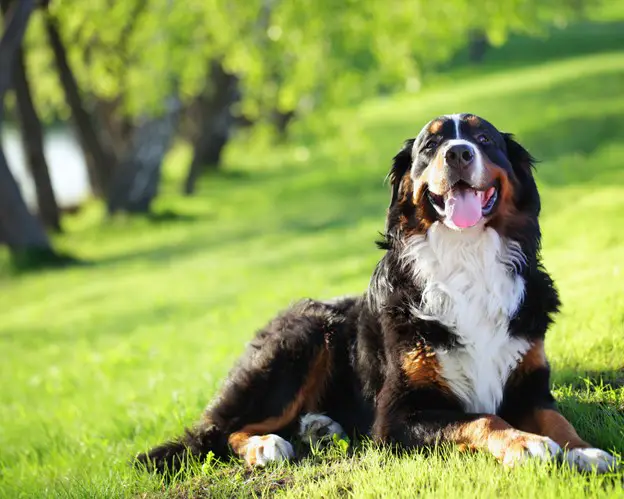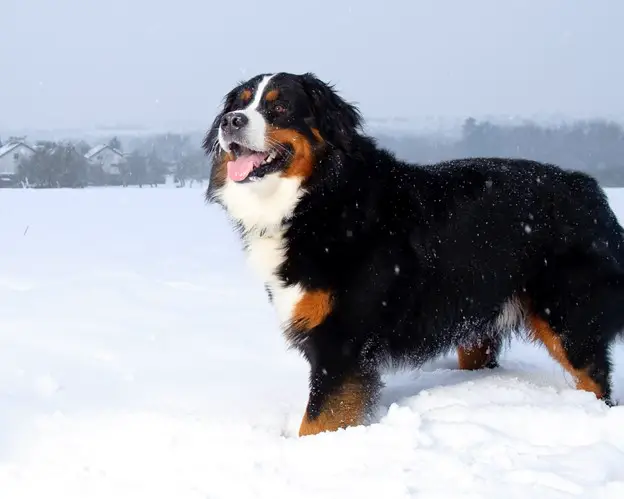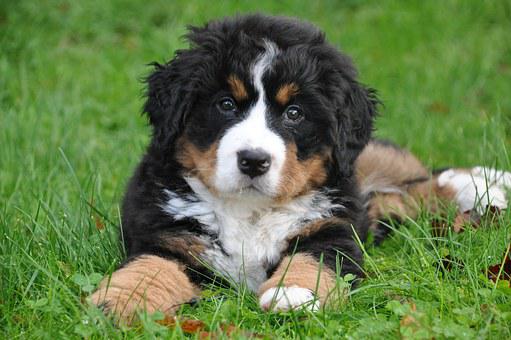The Bernese Mountain Dog is a well-known breed for many reasons: its protective nature, excellent work ethic, and muscular build, to name just a few. But what sets the Berner apart from other large, furry breeds is their unique coloring.
All pure-bred Berners are tricolored, with black, white, and red or rust shades adorning their beautiful coat. However, to meet the proper breed standard of a pure-bred, their colors and markings must be arranged precisely.
According to the Bernese Mountain Dog Club of America, a Bernese Mountain dog should be tri-colored. The ground color of a Bernese mountain dog should be jet black. The markings are rich rust and clear white. The symmetry of markings is desired in Bernese mountain dogs. Symmetry means that the colors/ markings that appear on the left part of the body of a Bernese mountain dog should also appear on its right side. Furthermore, rust should appear over each eye, on the cheeks reaching to at least the corner of the mouth, on each side of the chest, on all four legs, and under the tail.
Furthermore, there is a white blaze and muzzle band. A white marking on the chest typically forms an inverted cross. The tip of the tail is white. White on the feet is desired but must not extend higher than the pasterns.
Please continue reading to learn more about how Berner’s coloring sets them apart from the rest of the pack.

Are All Bernese Mountain Dogs Tri-Color?
While Bernese Mountain Dog mixes can come in various colors, true (pure-bred) Berners must have very particular coloring and marking patterns to be considered breed standard.
For instance, a pure-bred Berner will only come in a tri-color pattern of black, white, and red or rust coloring with a very specific pattern arrangement. First off, the white color around their nose should form a “horseshoe” pattern, resulting in a perfectly black nose.
In addition, the white coloring on the chest should create a cross pattern (commonly referred to as the “Swiss Cross.” And finally, there should be a noticeable pattern of white coloring surrounding the neck and throat. The fur arrangement in this particular area is known as the “Swiss Kiss.”

What is the “Swiss Kiss” of a Bernese Mountain Dog Coat?
A “Swiss Kiss” is a portion of white coloring around the neck and throat. This portion of the coat should form a partial ring of white around the neck but not a complete or connecting ring. According to the American Kennel Club’s compilation of breed standards, any other ground color than black or absence of these indicative markings is ground for immediate disqualification.
What Distinguishes the Bernese Mountain Dog From Other Tri-Colored Mountain Dogs?
The Bernese Mountain Dog is one of four tri-colored varieties of Swiss Mountain Dogs. The other three are the Appenzeller Sennenhund, the Entlebucher Sunnenhund, and the Greater Swiss Mountain Dog. While the tri-coloring of their coats is a bonding factor among these breeds, the Berner is easily distinguished from its close relatives by the length of its coat. The Bernese Mountain Dog is the only Swiss Mountain Dog to sport a coat of significant length.
Can the Bernese Mountain Dog Come in Any Other Color?
It is not uncommon for Berner mixes to come in a variety of colors. I, myself, have seen mixes that range from red to black and white to even blue merle. However, any variation of coloring will immediately disqualify a Berner from accomplishing their breed standard. A Berner of any color other than the unique black, white, and rust pattern is merely a mix and not to be considered pure-bred.
Do Bernese Mountain Dogs of Different Colors Have Different Personalities?
While there is no scientific evidence directly linking a Berner’s coloring to their personality traits, breeding standards can undoubtedly impact personality and behavior. The genetic features of a pure Bernese Mountain Dog create the makings of a peaceful, protective, gentle creature. Disturbing the gene pool could be detrimental to the existence of the breed itself. While there is no evidence to support that a mutation would create “bad” dogs, there is also no guarantee that a “Berner mutt” will have the same incredible personality as a pure-bred.
Do Bernese Mountain Dog Puppies Change Color As They Get Older?
Even newborn Bernese Mountain Dogs will sport the exact coloring and marking patterns as is the breed standard. It is very uncommon for pure-bred Berner puppies to change color as they age, though it is very common for there to be changes in the coat texture. Newborn Berner coats are very soft and fluffy. However, at the age of four to eight months, this puppy coat will shed out and be replaced with the more sleek-looking coat of an adult. Some Berner pups will have curls in the fur, which will often fade out to loose, more relaxed waves in adulthood.

Are All Bernese Mountain Dogs Black?
A true Bernese Mountain Dog’s ground (or primary) color will always be jet black. Berners were initially bred to herd and protect in the cold, harsh mountain weather. The darkness of their coat is meant to attract the sun’s warmth to the body, allowing the Berner to stay warm and comfortable despite the frigid outside temperatures. This ground color will be accompanied by patterns of white and rust along the body, making for a very handsome and visually appealing coat.
Can Bernese Mountain Dogs Be Red?
The coat of a true Bernese Mountain Dog will never be all red. However, there are visible “splashes” of red adorning portions of the coat, specifically around the face, paws, chest, and haunches. Bernadoodles (a Bernese Mountain Dog and Standard Poodle cross-breed) can be bred in a variety of colors, including brown, black, and red.
Can Bernese Mountain Dogs Be ONLY Black and White?
It is very uncommon for a Bernese Mountain Dog to be black and white only without the presence of their red or rust-colored markings. The absence of the red marking would disqualify a Berner from meeting the American Kennel Club’s standard for breed excellence. However, it will not affect their great personality or ability to be phenomenal canine companions.
Can a Bernese Mountain Dog Be Brown?
While a true Bernese Mountain Dog will never be brown primarily, it is possible for those marking that are usually red or rust (along the face, paws, chest, and haunches) to be a tan color instead. And while a rarity, this tan coloring will not disqualify them for consideration as pure-bred. In fact, many Berners will enter the show ring sporting tan markings instead of the traditional red without fear of disqualification.
Does Coloring Affect the Price of a Bernese Mountain Dog?
The average purchase cost for a pure-bred Bernese Mountain Dog can be anywhere from $1000-3000, though papered pooches bred for show can cost much more. Berner mixes, or those born with discoloration or any other genetic abnormality, tend to cost much less. This is unless, of course, the mix was bred intentionally for the purpose of sale (Bernadoodles, for example, are a very pricey mixed breed of the Berner family).
Is There Any Difference in Color Between Male and Female Bernese Mountain Dogs?
While the average height, weight, and build of a Bernese Mountain Dog can vary based on gender, the coloring should not. Regardless of age or gender, all true Berners should sport the signature tri-colored coat that is jet black, white, and red or rust.
In conclusion, the unique coloring and marking patterns of the Bernese Mountain Dog make this breed incredibly unique and one-of-a-kind. As described in this article, the characteristics of their specific color combination allow the Berner to be easily spotted, even in a large pack of dogs, and are just one of the many things that make this breed so special and unique.


